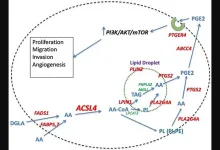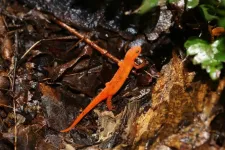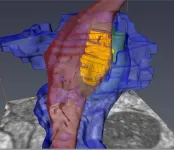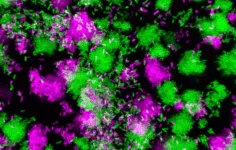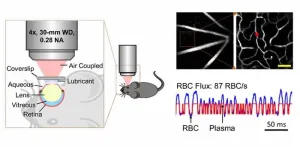(Press-News.org) From protecting biodiversity to ensuring the safety of drinking water, the biochemical makeup of rivers and streams around the United States is critical for human and environmental welfare. Studies have found that human activity and urbanization are driving salinization (increased salt content) of freshwater sources across the country. In excess, salinity can make water undrinkable, increase the cost of treating water, and harm freshwater fish and wildlife.
Along with the rise in salinity has also been an increase in alkalinity over time, and past research suggests that salinization may enhance alkalinization. But unlike excess salinity, alkalinization can have a positive impact on the environment due to its ability to neutralize water acidity and absorb carbon dioxide in the Earth’s atmosphere – a key component to combating climate change. Therefore, understanding the processes at play which are affecting salinity and alkalinity have important environmental and health implications.
A team of researchers from Syracuse University and Texas A&M University have applied a machine learning model to explore where and to what extent human activities are contributing to the hydrogeochemical changes, such as increases in salinity and alkalinity in U.S. rivers.
The group used data from 226 river monitoring sites across the U.S. and built two machine learning models to predict monthly salinity and alkalinity levels at each site. These sites were selected because long-term continuous water quality measurements have been recorded for at least 30 years. From urban to rural settings, the model explored a diverse range of watersheds, which are areas where all flowing surface water converges to a single point, such as a river or lake. It evaluated 32 watershed factors ranging from hydrology, climate, geology, soil chemistry, land use and land cover to pinpoint the factors contributing to rising salinity and alkalinity. The team’s models determined human activities as major contributors to the salinity of U.S. rivers, while rising alkalinity was mainly attributed more to natural processes than human activities.
The team, which included Syracuse University researchers Tao Wen, assistant professor in the College of Arts and Sciences’ Department of Earth and Environmental Sciences (EES), Beibei E, a graduate student in EES, Charles T. Driscoll, University Professor of Environmental Systems and Distinguished Professor in the College of Engineering and Computer Science, and Texas A&M assistant professor Shuang Zhang, recently had their findings published in the journal Science of the Total Environment.
What’s Driving Salinization and Alkalinization?
The results from the group’s sodium prediction model, which detected human activities such as the application of road salt as major contributions to the salinity of U.S. rivers, were consistent with previous studies. This model specifically revealed population density and impervious surface percentage (artificial surfaces such as roads) as the two most important contributors to higher salt content in U.S. rivers.
According to Wen, the accuracy of the salinity model provided an important proof of concept for the research team.
“In regard to causes of salinity in rivers, the results from our machine learning model matched those of previous studies which focused on field observation, lab work and statistical analysis,” says Wen. “This proved that our approach was working.”
With the salinity results confirming the accuracy of the team’s model, they then turned their attention to alkalinity. Their model identified natural processes as predominantly contributing to variation in river alkalinity, a contrast to previous research that identified human activities as the main contributor to alkalinization (Kaushal et al., 2018). They found that that local climatic and hydrogeological conditions including runoff, sediment, soil pH and moisture, were features most affecting river alkalinity.
Critical to the Carbon Cycle
Their findings have important environmental and climate implications as alkalinity in rivers forms a vital link in the carbon cycle. Consider the movement of carbon during a rainstorm. When it rains, carbon dioxide from the atmosphere combines with water to form carbonic acid. When the carbonic acid reaches the ground and comes into contact with certain rocks, it triggers a chemical reaction which extracts gaseous carbon dioxide from the atmosphere and transports it to the ocean via land water systems like lakes and rivers. Known as rock weathering, this natural process continuously erodes away rocks and sequesters atmospheric CO2 over millions of years. It is also a key regulator of greenhouse gases that contribute to global warming.
“Rock weathering is the primary source of alkalinity in natural waters and is one of the main ways to bring down carbon dioxide in air,” says Wen. Think of it as a feedback loop: when there is too much carbon dioxide in the atmosphere, temperatures increase leading to enhanced rock weathering. With more rock being dissolved into watersheds due to enhanced rock weathering, alkalinity rises and in turn brings down carbon dioxide.
“Alkalinity is a critical component of the carbon cycle,” says Wen. “While we found that natural processes are the primary drivers of alkalinization, these natural factors can still be changed by humans. We can alter the alkalinity level in rivers by changing the natural parameters, so we need to invest more to restore the natural conditions of watersheds and tackle global warming and climate changes to deal with alkalinization in U.S. rivers.”
The results from the team’s study can help inform future research about enhanced rock weathering efforts – where rocks are ground up and spread across fields. By distributing rock dust across large areas, it increases the amount of contact between rain and rock, which enhances carbon removal from the atmosphere. Wen says the team’s model can help answer questions about the evolution of natural conditions in different regions – an important step needed to implement enhanced rock weathering more effectively.
The work was funded through a $460,000 National Science Foundation grant awarded to Wen.
Citation:
E. Beibei, S. Zhang, C.T. Driscoll, Wen, T., Human and natural impacts on the U.S. freshwater salinization and alkalinization: A machine learning approach; Science of the Total Environment (2023), https://doi.org/10.1016/j.scitotenv.2023.164138
END
A machine learning approach to freshwater analysis
Syracuse University and Texas A&M researchers use computer modeling to find out the sources of salinization and alkalinization in U.S. watersheds.
2023-06-14
ELSE PRESS RELEASES FROM THIS DATE:
Inflammatory bowel disease linked to increased risk of stroke
2023-06-14
MINNEAPOLIS – People with inflammatory bowel disease (IBD) are more likely to have a stroke than people without the disease, according to a study published in the June 14, 2023, online issue of Neurology®, the medical journal of the American Academy of Neurology. The study does not prove that IBD causes stroke; it only shows an association.
Inflammatory bowel disease causes chronic inflammation of the intestines. It includes Crohn’s disease, ulcerative colitis and unclassified inflammatory bowel disease.
The study found that people with IBD were 13% more likely to have a stroke up to ...
UCF researcher’s innovative approach could redefine allergy treatment
2023-06-14
For years, research and therapies for allergic asthma have been focused largely on targeting the inflammatory cytokines in the body that react to allergens and cause overproduction of mucus, wheezing and difficulty breathing. Commonly prescribed drugs like Omalizumab, Dupilumab, Mepolizumab and Reslizumab lower or block the various cytokines and antibodies responsible for the asthmatic response, but they work after a patient’s airway inflammation is well underway.
Dr. Tigno-Aranjuez wanted to ...
ACSL4: Biomarker, mediator and target in quadruple negative breast cancer
2023-06-14
“ACSL4 has been demonstrated to play a pivotal role in both normal physiology as well as in a variety of disease states, including breast and other cancers.”
BUFFALO, NY- June 14, 2023 – A new review paper was published in Oncotarget's Volume 14 on June 12, 2023, entitled, “ACSL4: biomarker, mediator and target in quadruple negative breast cancer.”
Breast cancer is a heterogeneous disease for which effective treatment depends on correct categorization of its molecular subtype. ...
UTIA researchers find high risk to amphibians if fungal pathogen invades North America
2023-06-14
New research indicates the fungal pathogen Batrachochytrium salamandrivorans (Bsal) could be devastating to amphibian biodiversity if introduced to North America. Nature Communications published the findings June 5 from a group of researchers at the University of Tennessee Institute of Agriculture, the University of Massachusetts-Boston and Washington State University.
“We could see over 80 species of salamanders in the United States and 140 species in North America experience population declines if Bsal is introduced,” said Matt Gray, the lead author and professor of ...
New images capture unseen details of the synapse
2023-06-14
Scientists have created one of the most detailed 3D images of the synapse, the important juncture where neurons communicate with each other through an exchange of chemical signals. These nanometer scale models will help scientists better understand and study neurodegenerative diseases such as Huntington’s disease and schizophrenia.
The new study appears in the journal PNAS and was authored by a team led by Steve Goldman, MD, PhD, co-director of the Center for Translational Neuromedicine at the University of Rochester and the University of Copenhagen. The findings represent a significant technical achievement ...
New UCF project launched to engage a diverse, new generation of researchers to aid aging populations
2023-06-14
ORLANDO, June 14, 2023 — The number of older adults in the U.S. population is growing, expecting to nearly double by 2060, and becoming more diverse with racial and ethnic minority populations projected to increase by 105% by 2040.
“As a society, we’re not ready for that,” says Norma Conner, a professor in the University of Central Florida’s College of Nursing. “We need to be cognizant of the large population of older adults that is going to be ours to care for, and we need to have a better understanding that reflects them.”
To ...
Stanford Medicine and Stanford Institute for Human-Centered Artificial Intelligence announce RAISE-Health, a responsible AI initiative
2023-06-14
Responding to rapid advances in artificial intelligence and the urgent need to define its responsible use in health and medicine, Stanford Medicine and the Stanford Institute for Human-Centered Artificial Intelligence (HAI) today announced the launch of RAISE-Health (Responsible AI for Safe and Equitable Health). This pioneering initiative seeks to address critical ethical and safety issues surrounding AI innovation and help others navigate this complex and evolving field.
Co-led by Stanford School ...
Scientists discover small RNA that regulates bacterial infection
2023-06-14
People with weakened immune systems are at constant risk of infection. Pseudomonas aeruginosa, a common environmental bacterium, can colonize different body parts, such as the lungs, leading to persistent, chronic infections that can last a lifetime – a common occurrence in people with cystic fibrosis.
But the bacteria can sometimes change their behavior and enter the bloodstream, causing chronic localized infections to become acute and potentially fatal. Despite decades of studying the transition in lab environments, how and why the switch happens in humans has remained unknown.
However, researchers ...
Making immunotherapy safer
2023-06-14
Researchers at the University of Houston are working to make T-cell immunotherapy safer, developing a tool called CrossDome, which uses a combination of genetic and biochemical information to predict if T-cell immunotherapies might mistakenly attack healthy cells.
T-cell based immunotherapies hold tremendous potential in the fight against cancer and infectious diseases, thanks to their capacity to specifically target diseased cells, including cancer metastasis. Nevertheless, this potential has been tempered with safety concerns regarding ...
Eyeing the brain: Predicting cerebrovascular diseases with retinal imaging
2023-06-14
The brain is one of the most metabolically active organs in the human body. Although it represents only about 2 percent of the human body’s weight, it receives 15 to 20 percent of the body’s total blood supply. Disrupted blood flow to the brain over a long period of time, a condition known as “chronic cerebral hypoperfusion” (CCH), can lead to serious cerebrovascular diseases such as white matter disease.
CCH manifests as lesions in the white matter, a brain region vulnerable to problems with blood supply. Unfortunately, CCH has no available cure. An early diagnosis by visualizing the microvascular changes in the brain that occur prior to lesion ...
LAST 30 PRESS RELEASES:
Singapore scientists discover lung cancer's "bodyguard system" - and how to disarm it
Bacteria use wrapping flagella to tunnel through microscopic passages
New critique prompts correction of high-profile Yellowstone aspen study, highlighting challenges in measuring ecosystem response to wolf reintroduction
Stroke survivors miss critical treatment, face greater disability due to systemic transfer delays
Delayed stroke care linked to increased disability risk
Long term use of anti-acid drugs may not increase stomach cancer risk
Non-monetary 'honor-based' incentives linked to increased blood donations
Natural ovulation as effective as hormones before IVF embryo transfer
Major clinical trial provides definitive evidence of impacts of steroid treatment on severe brain infection
Low vitamin D levels shown to raise risk of hospitalization with potentially fatal respiratory tract infections by 33%
Diagnoses of major conditions failing to recover since the pandemic
Scientists solve 66 million-year-old mystery of how Earth’s greenhouse age ended
Red light therapy shows promise for protecting football players’ brains
Trees — not grass and other greenery — associated with lower heart disease risk in cities
Chemical Insights scientist receives Achievement Award from the Society of Toxicology
Breakthrough organic crystalline material repairs itself in extreme cold temperatures, unlocking new possibilities for space and deep-sea technologies
Scientists discover novel immune ‘traffic controller’ hijacked by virus
When tropical oceans were oxygen oases
Positive interactions dominate among marine microbes, six-year study reveals
Safeguarding the Winter Olympics-Paralympics against climate change
Most would recommend RSV immunizations for older and pregnant people
Donated blood has a shelf life. A new test tracks how it's aging
Stroke during pregnancy, postpartum associated with more illness, job status later
American Meteorological Society announces new executive director
People with “binge-watching addiction” are more likely to be lonely
Wild potato follows a path to domestication in the American Southwest
General climate advocacy ad campaign received more public engagement compared to more-tailored ad campaign promoting sustainable fashion
Medical LLMs may show real-world potential in identifying individuals with major depressive disorder using WhatsApp voice note recordings
Early translational study supports the role of high-dose inhaled nitric oxide as a potential antimicrobial therapy
AI can predict preemies’ path, Stanford Medicine-led study shows
[Press-News.org] A machine learning approach to freshwater analysisSyracuse University and Texas A&M researchers use computer modeling to find out the sources of salinization and alkalinization in U.S. watersheds.


